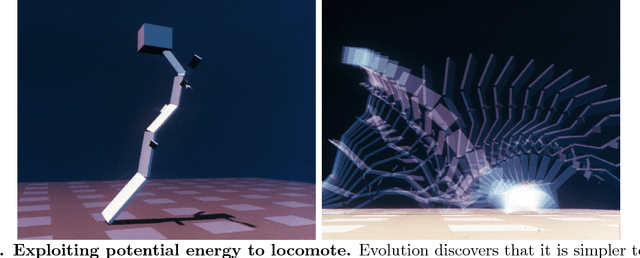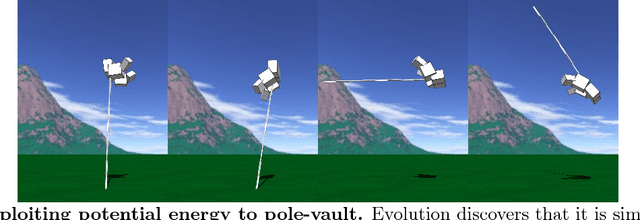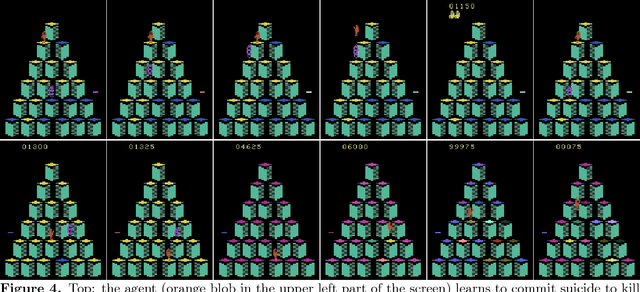Fred C. Dyer
The Surprising Creativity of Digital Evolution: A Collection of Anecdotes from the Evolutionary Computation and Artificial Life Research Communities
Aug 14, 2018



Abstract:Biological evolution provides a creative fount of complex and subtle adaptations, often surprising the scientists who discover them. However, because evolution is an algorithmic process that transcends the substrate in which it occurs, evolution's creativity is not limited to nature. Indeed, many researchers in the field of digital evolution have observed their evolving algorithms and organisms subverting their intentions, exposing unrecognized bugs in their code, producing unexpected adaptations, or exhibiting outcomes uncannily convergent with ones in nature. Such stories routinely reveal creativity by evolution in these digital worlds, but they rarely fit into the standard scientific narrative. Instead they are often treated as mere obstacles to be overcome, rather than results that warrant study in their own right. The stories themselves are traded among researchers through oral tradition, but that mode of information transmission is inefficient and prone to error and outright loss. Moreover, the fact that these stories tend to be shared only among practitioners means that many natural scientists do not realize how interesting and lifelike digital organisms are and how natural their evolution can be. To our knowledge, no collection of such anecdotes has been published before. This paper is the crowd-sourced product of researchers in the fields of artificial life and evolutionary computation who have provided first-hand accounts of such cases. It thus serves as a written, fact-checked collection of scientifically important and even entertaining stories. In doing so we also present here substantial evidence that the existence and importance of evolutionary surprises extends beyond the natural world, and may indeed be a universal property of all complex evolving systems.
Exploring the coevolution of predator and prey morphology and behavior
Feb 29, 2016



Abstract:A common idiom in biology education states, "Eyes in the front, the animal hunts. Eyes on the side, the animal hides." In this paper, we explore one possible explanation for why predators tend to have forward-facing, high-acuity visual systems. We do so using an agent-based computational model of evolution, where predators and prey interact and adapt their behavior and morphology to one another over successive generations of evolution. In this model, we observe a coevolutionary cycle between prey swarming behavior and the predator's visual system, where the predator and prey continually adapt their visual system and behavior, respectively, over evolutionary time in reaction to one another due to the well-known "predator confusion effect." Furthermore, we provide evidence that the predator visual system is what drives this coevolutionary cycle, and suggest that the cycle could be closed if the predator evolves a hybrid visual system capable of narrow, high-acuity vision for tracking prey as well as broad, coarse vision for prey discovery. Thus, the conflicting demands imposed on a predator's visual system by the predator confusion effect could have led to the evolution of complex eyes in many predators.
* 8 pages, 8 figures, submitted to Artificial Life 2016 conference
Exploring the evolution of a trade-off between vigilance and foraging in group-living organisms
Aug 08, 2014



Abstract:Despite the fact that grouping behavior has been actively studied for over a century, the relative importance of the numerous proposed fitness benefits of grouping remain unclear. We use a digital model of evolving prey under simulated predation to directly explore the evolution of gregarious foraging behavior according to one such benefit, the "many eyes" hypothesis. According to this hypothesis, collective vigilance allows prey in large groups to detect predators more efficiently by making alarm signals or behavioral cues to each other, thereby allowing individuals within the group to spend more time foraging. Here, we find that collective vigilance is sufficient to select for gregarious foraging behavior as long there is not a direct cost for grouping (e.g., competition for limited food resources), even when controlling for confounding factors such as the dilution effect. Further, we explore the role of the genetic relatedness and reproductive strategy of the prey, and find that highly related groups of prey with a semelparous reproductive strategy are the most likely to evolve gregarious foraging behavior mediated by the benefit of vigilance. These findings, combined with earlier studies with evolving digital organisms, further sharpen our understanding of the factors favoring grouping behavior.
* 26 pages (double-spaced, single column), 6 figures, 2 SI figures
Predator confusion is sufficient to evolve swarming behavior
Apr 03, 2013



Abstract:Swarming behaviors in animals have been extensively studied due to their implications for the evolution of cooperation, social cognition, and predator-prey dynamics. An important goal of these studies is discerning which evolutionary pressures favor the formation of swarms. One hypothesis is that swarms arise because the presence of multiple moving prey in swarms causes confusion for attacking predators, but it remains unclear how important this selective force is. Using an evolutionary model of a predator-prey system, we show that predator confusion provides a sufficient selection pressure to evolve swarming behavior in prey. Furthermore, we demonstrate that the evolutionary effect of predator confusion on prey could in turn exert pressure on the structure of the predator's visual field, favoring the frontally oriented, high-resolution visual systems commonly observed in predators that feed on swarming animals. Finally, we provide evidence that when prey evolve swarming in response to predator confusion, there is a change in the shape of the functional response curve describing the predator's consumption rate as prey density increases. Thus, we show that a relatively simple perceptual constraint--predator confusion--could have pervasive evolutionary effects on prey behavior, predator sensory mechanisms, and the ecological interactions between predators and prey.
* 11 pages, 6 figures. Supplementary information (including video files S1 and S5) in ancillary material. Videos S2-S4 are available from the authors upon request
 Add to Chrome
Add to Chrome Add to Firefox
Add to Firefox Add to Edge
Add to Edge